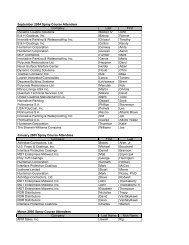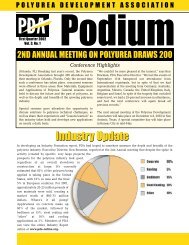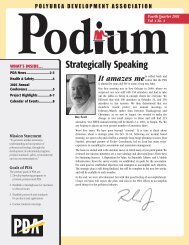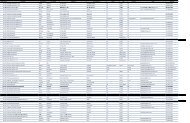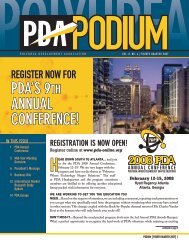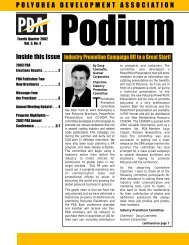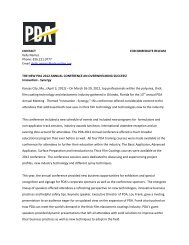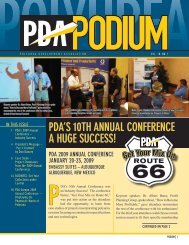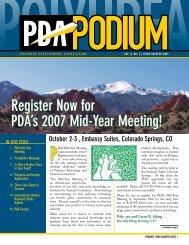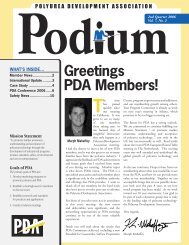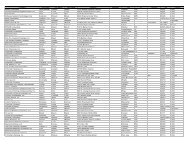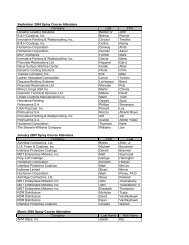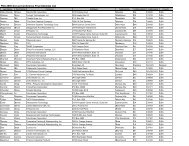PDA's 9th Annual Conference a Huge SUCCESS! - Polyurea ...
PDA's 9th Annual Conference a Huge SUCCESS! - Polyurea ...
PDA's 9th Annual Conference a Huge SUCCESS! - Polyurea ...
You also want an ePaper? Increase the reach of your titles
YUMPU automatically turns print PDFs into web optimized ePapers that Google loves.
FROM THE SAFETY COMMITTEE<br />
Eight Major Mistakes (Or,<br />
What Not to Do When Workers’<br />
Compensation Rates Drop) By Frank Pennachio<br />
When workers’ compensation rates decline,<br />
don’t shift your attention to other parts of<br />
the business or become complacent.<br />
Throughout much of the country, declining workers’ compensation<br />
rates are music to employers’ ears. After all, that seems like longawaited<br />
good news, particularly since workers’ compensation is<br />
more often than not viewed as a necessity and a significant cost<br />
of doing business.<br />
Yet, looking at workers’ compensation as a business necessity or<br />
a commodity is a major fallacy. Although most employers fail to<br />
recognize it, workers’ compensation is a core business practice<br />
and a means for improving the bottom line.<br />
Rather than diverting attention and finances to other business<br />
priorities during periods of lower workers’ compensation rates,<br />
employers can benefit by taking steps to guarantee long-term<br />
savings. Here are eight mistakes employers should avoid so they<br />
can achieve long-term workers’ compensation savings.<br />
1. Confusing Lower Premium Rates with Cost Reductions<br />
Many employers are surprised to learn that a reduction in workers’<br />
compensation rates does not always mean a reduction in costs.<br />
Let’s begin with a basic understanding of what determines the<br />
cost of workers’ compensation insurance. Unlike other insurance,<br />
workers’ compensation functions like a credit line to finance the<br />
costs of injuries. As such, rates alone do not determine the overall<br />
cost An experience modification factor (Mod) tailors the cost of<br />
insurance to the individual loss performance of an employer. A<br />
workers’ compensation premium is calculated by this formula:<br />
Rate x $100 payroll x experience modifier.<br />
The Mod calculation is complex, but in general, an employer<br />
is compared with similar employers in the same industry<br />
classification and if past losses are lower than average, a credit<br />
rating reduces the premium. Conversely, if past losses are higher<br />
than average, a debit rating can actually increase costs in spite of<br />
lower rates.<br />
2. Becoming Complacent<br />
Declining rates act as blinders for many employers. With lower<br />
prices, it’s easy to shift focus away from injury management and<br />
cost containment to other, more pressing business matters.<br />
While increased attention to safety led to a decline in the number<br />
of workplace accidents, resulting in fewer claims and lower rates,<br />
claim frequency is only one part of the equation. The other part,<br />
claim cost including indemnity (lost wages) and medical care,<br />
continues to rise.<br />
In many industries where there are tight labor markets, wage<br />
gains are expected to trend higher, suggesting further increases<br />
in indemnity severity. At the same time, medical care costs have<br />
marched relentlessly upward since the mid 1990s.<br />
Even more disturbing is the fact that the growth in workers’<br />
compensation medical costs has been much steeper than in the<br />
health care industry as a whole, indicating that it is not only<br />
medical inflation but a mix of services and over-utilization that<br />
are driving up costs.<br />
If claims remain open and injury costs escalate, reserves (estimate<br />
of ultimate cost of injury) rise and adversely affect the employer’s<br />
experience modification factor, thus increasing costs. Employers<br />
need to understand what is impacting medical costs and measure<br />
key metrics such as cost per claim trends adjusted for diagnosis<br />
and severity.<br />
3. Focusing Only on Direct Costs<br />
Ask a business person how much he or she spends on workers’<br />
compensation and almost all will respond with the price of the<br />
premium. Yet, the direct costs of workers’ compensation often<br />
represent only 20 percent to 30 percent of the overall injury<br />
expenses.<br />
Indirect costs, including overtime, temporary labor, increased<br />
training, supervisor time, production delays, unhappy customers,<br />
increased stress and property or equipment damage represent<br />
several times the direct cost of the injury. A 2002 Safety Index<br />
report by Liberty Mutual tallied the direct cost of workplace<br />
injuries at $40.1 billion. The total financial impact of both direct<br />
and indirect costs was estimated to be as much as $240 billion.<br />
Injury costs – both direct and indirect – will have a much greater<br />
impact on an employers’ overall costs than rate decreases.<br />
4. Thinking That Rates Will Stay Low<br />
Historically, the workers’ compensation price cycle has repeated<br />
in a predictable pattern: Rates decline, insurance is purchased<br />
for a lower price, employers shift focus away from workers’<br />
compensation, claim costs do not fall in relationship to reduced<br />
rates and employers’ Mod increases, legislative reforms erode<br />
CONTINUED ON PAGE 10<br />
PODIUM | FIRST QUARTER 2008 |



